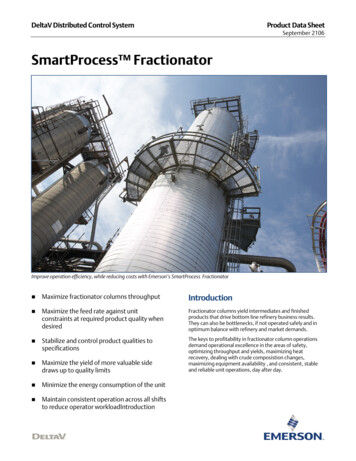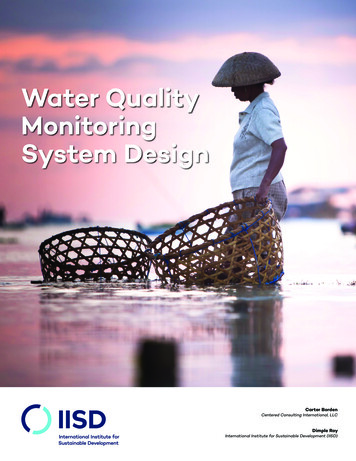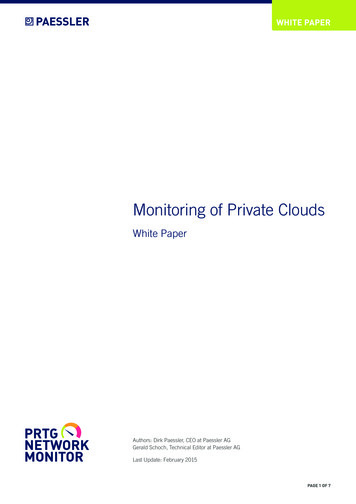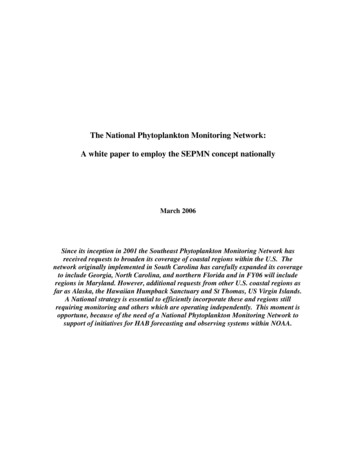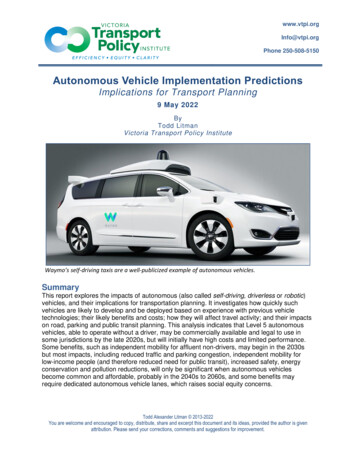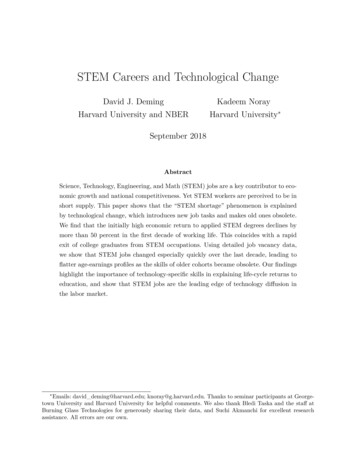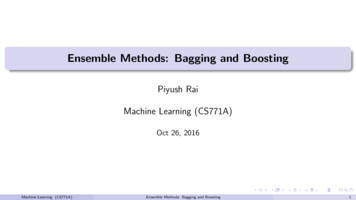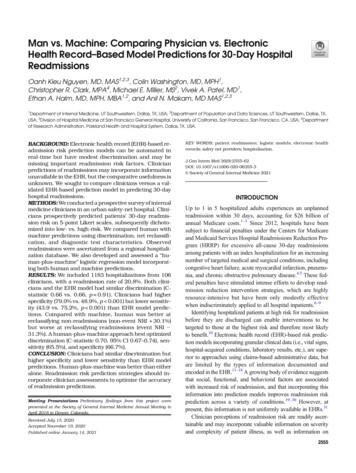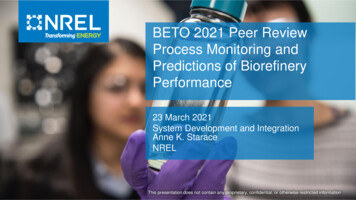
Transcription
BETO 2021 Peer ReviewProcess Monitoring andPredictions of BiorefineryPerformance23 March 2021System Development and IntegrationAnne K. StaraceNRELThis presentation does not contain any proprietary, confidential, or otherwise restricted information
Project OverviewGoal: Accelerate the commercialization of biomass-derived fuels and chemicalsthrough the development of online process monitoring and prediction toolsto enable real-time adjustments during plant operationImpact: Enabling quick process optimization responses and reducing costsassociated with process downtime, off-specification product distributions, andmisdirected resourcesOutcome: De-risked pathway for the generation of predictive tools from on-line massspectral analysis that will be integrated into a refinery's distributed controlsystem Predictive tool specific to co-processing bio-oil and vacuum gas oil (VGO) ina Davison Circulating Riser (DCR) reactorNREL 2
Project eedbackRel. int.Analytical Tool: On-line, slip streamvapor phase mass spectrometrym/zBenchmark: gaschromatography-based analysisof condensed productOpportunity to obtain faster (seconds tominutes vs. hours) feedback on productcomposition that is desired by refinersBased on NREL/PNNL model for a large,complex, Gulf Coast refinery, the teamestimates the risk of off-spec penaltieson order of 10,000 to 100,000 per 3hour eventNREL 3
Project Overview: Pivot of Initial Starting PointCatalytic pyrolysis of pine with Pt/TiO2Co-processing of pyrolysis oils and vacuum gas oil (VGO) with a fluid catalyticcracking (FCC) catalystPyrolysisOilVGO NREL 4
Market TrendsNREL’s Bioenergy Program Is Enabling aSustainable Energy Future by Respondingto Key Market NeedsValue Proposition Online process monitoring coupled with rapidpredictive tools will provide real-timefeedback and process control oncomparatively new feeds, processes, andproductsKey Differentiators Online mass spectrometry of hot vapors is acapability that can directly track intermediatesand products, rather than tracking processconditions like temperature and pressure Leader in developing hot vapor mass spectralanalysis as a high-throughput analyticaltechnique Access to pilot-scale Davison CirculatingNREL 5Riser reactor with online mass spectrometry
1. Management: Risk MitigationRisks: Many points of datahandoff Difficulty maintainingindustrial relevancy3.4.3.302Bio Oil lTask3.1.1.011PM&PModelingTaskMitigations: Bi-weekly meetingsbetween teammembers Data and metadataposted same-day oninternally sharedplatform Formatted data sharedon LabKey Request input fromindustrial advisor atPhillips 66 andindustrial review boardfor Bio Oil Coprocessing task NREL 6
1. Management: Processes and CoordinationBio-oil Co-processing ProjectPM&P Modeling TaskPM&P Experimental TaskData GenerationModelBuildingModelTestingEvaluation AccuracyBreadthLeveraging experimentsComplementing experimentsPM&P Experimental TaskPM&P Modeling TaskBio-oil Co-processing ProjectNREL 7
2. Approach: Building on Past veModelLigninContentSuccessfully rapidly predicted lignin content and S:G lignin ratio using predictivemodels coupled with py-MBMS – reduced analysis time from days to minutesBiofuels Methods and Protocols 2009, 581, 12Bioenergy Research 2014, 7, 899–908NREL 8
2. Approach: Building Data Sets to Enable ModelingPyrolysisOilVGOModel building with: Process conditions Real-time vapor phasemass spectra Gas-chromatographybased characterization ofcondensed productVapor PhaseUpgrading RealtimeMass Spec.GCRel. int.Span relevant variables formodel buildingm/zPredictive Model BuildingAdd knowledge of reactionmechanisms throughadditional model compoundworkNREL 9
2. Approach: Using Model for Faster FeedbackPyrolysisOilVGOVapor PhaseUpgradingHours RealtimeMass Spec.Rel. int.GCModel used to obtain rapidfeedback from online massspectra alone – reduce timefrom hours to secondsm/zOn-line Predictive ModelSecondsNREL 10
2. Approach: Data Generation Across cal: use modelcompound experiments,historical data, and literature toidentify reactions. Improvesaccuracy over fully empiricalmodel.Model Compounds StudiesInnovation opportunityBench-scale:Sweep Experimental Space withReal VaporsOpportunity for optimization notfeasible on pilot scalePilot Scale:Davison Circulating Riser (DCR)Validation: Set aside subset ofexperimental data at each scaleas test set to validate modelbuilt with remaining dataMost reliable for model-buildingMost directly-translatable to industryNREL 11
2. Approach : Uses of Data Sets in Model Development andTrainingModel compounds andVGO upgraded over FCCcatalysts on microscalewith MS analysisPine pyrolysis vapors andVGO upgraded over FCCcatalyst with MS and GCanalysisOnline slip-stream MSduring DCR co-processingruns and subsequent oilcharacterizationIncorporation of additional reactionpathways into modelModel training withexperimental dataReserved experimentaldata sets for validation8090%1020%NREL 12
2. Approach: Risk MitigationTop Potential Challenges Unacceptably large uncertainty Data collected across scalesGo/ No Go Mitigations Add more data / variables to model Incorporate knowledge of reactionpathways Optimize sampling techniques tomass spectrometer Use of standards Submit condensed product foradditional analysis if necessaryComparison of predictedcondensed product componentconcentrations from on-line massspectra with componentconcentrations measured fromanalysis of condensed productfrom co-processing experimentsrun on NREL’s DCR reactor forthe Bio-oil Co-processing ProjectNREL 13
3. ImpactEnabling quick process optimization responses and reducing costs associated withprocess downtime, off-specification product distributions, and misdirected resourceswhen converting renewable feedstocks at refinery-scale. Once expanded to all unit operations, these online process monitoring andprediction tools contribute to digitization of refineries and enable use of artificialintelligence (AI) to control process conditions Program will be shared open source on Github and process shared in BiofuelsDigest 8 Slide Guide, in addition to publication and conferencepresentations, to assistrefinery development ofProductsoft sensors tailored tocompositions intheir specific processesminutes ratherthan hoursNREL 14
4. Progress and Outcomes: Increased ExperimentalThroughput and ReproducibilityCompleted design, assembly,readiness verification (RV), andreproducibility assessment ofonly multibed, high throughputmicroscale reactor at NRELcoupled with autosamplerIncreases throughput 10xReproducibility assessmentdecreased day-to-day variability: 3x with improved sampling ofbiomass vapors Additional 30% withcalibration standard correctionNREL 15
4. Progress and Outcomes: Data ManagementData management system developed for efficient development of predictivemodels and collaboration between other projects and laboratoriesDatabase in the LabKey serverList of experimentalrunsCFP4 AmuI100.0110.012 3.5E 7 ( Additional fields regardingexperimental conditions)MassspectrumPythonAPI acFR Sample FP/CFP SampleID#acFRCFP1acFRCFP2acFRCFP3Using the Python application programming interface (API) for LabKey to upload dataData analysis using structured query language (SQL)Eliminates copy/paste error, increases throughput, enables collaborationNREL 16
4. Progress and Outcomes : Preliminary ModelSuccessfully Predicts Catalytic UpgradingDeveloped a simple neural network model with one hidden layer using historic dataW1(200x200)Construction and Demolition Waste6(Predicted CFP spectra were inverted forvisual clarity)4Input18 FP spectra(200x1)W2(200x200)Output18 CFP spectra(200x1)20m/z-2R2: 0.99,Mean AbsoluteError: 0.005-4-6CFP(experiment)CFP(Predicted)Accurate preliminary result, butlimited in complexity (18experiments)Model can only predict amount ofcomplexity it was trained onNREL 17
4. Progress and Outcomes: Reaction PathwaysIncorporated into Co-Processing ModelIdentified co-processing reactions from literature and historic data and incorporatedinto new neural network model for co-processingExample SMARTS pattern of hydrodeoxygenation (HDO) via hydrogen transferfrom alkane (VGO) to phenolics (bio-oil) during co-processing:[C:1]-[C:2]. [c:3]1:[c:4]:[c:5]:[c:6]:[c:7](-[O:9]):[c:8]:1 [C:1] [C:2]. [c:3]1:[c:4]:[c:5]:[c:6]:[c:7]:[c:8]:1. [O:9]NREL 18
SummaryManagement: Iteratively evaluate needs with feedback from experimental task,modeling tasks, Bio-oil Co-processing project, and industrial advisorsTechnical Approach: Collect experimental data sets across scales to developa predictive model to predict condensed product component concentrationsfrom online mass spectraImpact: Enabling quick process optimization responses and reducing costsassociated with process downtime, off-specification product distributions, andmisdirected resourcesProgress: Increased throughput of microscale catalytic experiments to enablesufficient data generation for development of statistical models Preliminary neural network model and data management system developedNREL 19
Quad Chart OverviewProject GoalTimeline Start: 1 October 2019 Finish: 30 September 2022FY20(10/01/2019 –9/30/2020)DOEFunding 500,000.00Active ProjectFY20 500,000.00FY21 400,000.00FY22 TBDProject Partners (NA)Barriers addressedThrough the development of a predictive toolspecific to co-processing of VGO andpyrolysis oil over FCC catalyst, provide atemplate for the development of predictivemodels based on on-line, slip stream massspectrometry that can be applied to a varietyof unit operations, feeds, and catalysts.End of Project MilestoneImprove statistical computational tool specificto co-processing pyrolysis oil and VGO in anFCC unit, post program open source onGitHub, and publicize (Biofuels Digest,conference presentations, publications) toprovide refinery operators with an acceleratedpathway to develop predictive tools specificto their unit operations and processes.Ft-J Operational ReliabilityADO-G Co‐Processing with Petroleum RefineriesFunding Mechanism NANREL 20
AcknowledgementsExperimental TeamJosh JacksonCalvin MukarakateAnne StaraceAnne “Liz” WareModeling TeamSeonah KimYeonjoon KimPeter St. JohnBio-oil Co-processing PIsKim MagriniHuamin WangZhenghua LiIndustrial AdvisorCory PhillipsNREL 21
Q&Awww.nrel.govThis work was authored by the National Renewable Energy Laboratory, operated by Alliance for Sustainable Energy,LLC, for the U.S. Department of Energy (DOE) under Contract No. DE-AC36-08GO28308. Funding provided by theU.S. Department of Energy Office of Energy Efficiency and Renewable Energy Bioenergy Energy Technologies Office.The views expressed in the article do not necessarily represent the views of the DOE or the U.S. Government. TheU.S. Government retains and the publisher, by accepting the article for publication, acknowledges that the U.S.Government retains a nonexclusive, paid-up, irrevocable, worldwide license to publish or reproduce the publishedform of this work, or allow others to do so, for U.S. Government purposes.
CFP(ex per i m en t ) CFP(Pr edi c t ed) (Predicted CFP spectra were inverted for visual clarity) m/z R2: 0.99, Mean Absolute Error: 0.005 Accurate preliminary result, but limited in complexity (18 experiments) Model can only predict amount of complexity it was trained on Input 18 FP spectra (200x1) Output 18 CFP spectra (200x1) W 1 (200x200) 2 .


